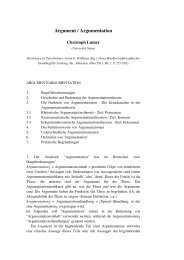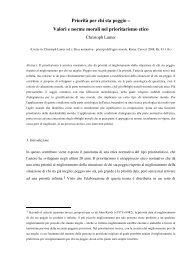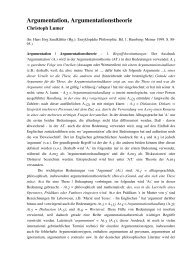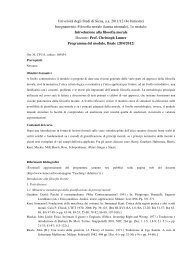What is Practical Knowledge? - Prof. Dr. Christoph Lumer
What is Practical Knowledge? - Prof. Dr. Christoph Lumer
What is Practical Knowledge? - Prof. Dr. Christoph Lumer
You also want an ePaper? Increase the reach of your titles
YUMPU automatically turns print PDFs into web optimized ePapers that Google loves.
<strong>Lumer</strong>: <strong>What</strong> Is <strong>Practical</strong> <strong>Knowledge</strong>? 175. Implementing the Strategy -- Deliberation Analys<strong>is</strong> and its Implications forDetermining <strong>Practical</strong> <strong>Knowledge</strong>The first step in implementing the strategy for identifying practical knowledge <strong>is</strong> to analyze thevarious ways to decide. Th<strong>is</strong> <strong>is</strong> not the place to do so in detail. However, the general structure of thesystematic dec<strong>is</strong>ion steps and some details of one exemplary step can be described here. 12The general structure of dec<strong>is</strong>ion <strong>is</strong> th<strong>is</strong>. The first element cons<strong>is</strong>ts of more or less inborn ororiginal criteria for intrinsically assessing the outcomes of actions. (In order not to constantly repeat"action and its outcomes" the action itself may be counted as an outcome too.) During a dec<strong>is</strong>ionthese criteria can be applied to appra<strong>is</strong>e the assumed outcomes of actions according to theirassumed intrinsically relevant descriptive features. However, often the subjects use storedvaluations of intrinsically relevant outcomes or of intermediate outcomes with several intrinsicallyrelevant consequences so that during a particular deliberation the descriptive features of theoutcomes need not be considered (again).The second element of dec<strong>is</strong>ions cons<strong>is</strong>ts of a variety of criteria for aggregating (i) intrinsicvaluations of intrinsically relevant outcomes to a prospect valuation of an action itself or ofintermediate consequences or (ii) for aggregating prospect valuations of such intermediateconsequences to a prospect valuation of the action leading to these consequences. The aggregationtakes into account the intrinsic or prospect values of the various consequences and their subjectiveconditional probability dependent on the intermediate consequence or the action. I said there <strong>is</strong> avariety or richness of such criteria, which are studied in psychological and economic dec<strong>is</strong>iontheory (overviews: Camerer 1995; Koehler & Harvey 2004, parts I; III). The agents seem to inventthem, on the bas<strong>is</strong> of a rough idea of what a prec<strong>is</strong>e prospect valuation would look like, with theaim to more or less approach th<strong>is</strong> prec<strong>is</strong>e valuation by a more or less complicated and "expensive"appra<strong>is</strong>al procedure. The array extends from rather accurate but "expensive" procedures on the oneend to inaccurate but "cheap" appra<strong>is</strong>al procedures on the other end. The most simple appra<strong>is</strong>alprocedure <strong>is</strong> captured by the scheme for a practical inference (cf. above, sect. 3.3); more complexand exact appra<strong>is</strong>al procedures are similar to the models proposed in rational dec<strong>is</strong>ion theory. (Inbetween there are also criteria for a comparative valuation of two or more possible intermediateconsequences or actions, so that the result of the application of these criteria <strong>is</strong> only 'a <strong>is</strong> better thanb'; such results may then be combined in a knockout system for identifying the best option.)Probabil<strong>is</strong>tic outcomes very often are not weighted proportionally to their probability (cf. e.g.Kahneman & Tversky 1979). The various criteria are used on different occasions. Which of thesemany aggregation methods <strong>is</strong> used in a particular deliberation depends, of course, on the availabledata; in addition, however, there <strong>is</strong> some tendency to optimize the dec<strong>is</strong>ion process: "cheap" butinaccurate appra<strong>is</strong>al procedures are used for unimportant dec<strong>is</strong>ions -- where the gains obtainable by12 A much more detailed exposition <strong>is</strong> given in: <strong>Lumer</strong> 2007; 2005. A full exposition of a general empiricaldeliberation analys<strong>is</strong> <strong>is</strong> provided in: <strong>Lumer</strong> 2000 (pp. 128-240; 428-521); and of moral dec<strong>is</strong>ions in: <strong>Lumer</strong>2002.





![Vorwort [Biographie und Laudatio Wolfgang Lenzen]](https://img.yumpu.com/40262871/1/184x260/vorwort-biographie-und-laudatio-wolfgang-lenzen.jpg?quality=85)

